In English after each paragraph

Shiva, Shiva pas...pas facile pour aller de Munnar à Mysore. Le train étant complet, il nous reste l'option "GOZO CAB", beaucoup plus cher mais possibilité de réserver en ligne et de connaître le montant à payer, le nom du chauffeur mais pour cela, il faut avoir un cell et une carte SIM. Bref, tout est possible...juste un peu de patience ou beaucoup.
I go, I don't go... not easy to go from Munnar to Mysore. As the train was full, we took the option of GozoCabs, way more expensive but easy to book on line, know how much to pay and the name of the driver. Good to have a SIM card. Everything is possible... with just some patience or a lot of it...
Un exercice pas toujours des plus faciles, puisqu'il faut à la fois être zen , garder le sourire et ravaler ses frustrations. Connaissez vous ce proverbe indien qui résume tout à lui tout seul.
Not always easy, as you need to stay zen, keep a smile on and eat up your frustrations. One Indian saying goes like that:
"Tout occidental qui vient en Inde acquiert la patience s'il n'en a pas et la perd s'il en a"
''A westerner coming to India acquires patience if he does not have any, and looses it if he has some''.
Bref, le parcours pour rejoindre notre prochaine destination Mysore fut long et montagneux, croisant au moins 2 parcs nationaux qui mettent en garde le passage d'animaux sauvages, éléphants, tigres, etc. On en a vu aucun, pas l'ombre d'une trompe, rien. Mais qu'est ce qu'on aurait aimé être en moto. Ça valait au moins certains parcours que nous avions eu le privilège de faire au Mexique.
It was tedious to reach our next destination Mysore, because long, hilly with 2 national parks indicating that there were some wild animals, elephants, tigers. We did not see any anymal, not the shadow of a trump, nothing. But how we would have wanted to be on our motorcycle, worth some of the roads we rode in Mexico.

Mysore fut à date notre ville préférée, un vrai coup de coeur. Une ville mouvementée (on est en Inde) mais dotée de belles et larges avenues si bien que la ville donne l'impression d'être aérée. Bon, qu'on se rassure tout de suite, la klaxonmania fait toujours partie du décor, d'ailleurs vous êtes encouragé à klaxonner. Sur les tuk-tuks ou camions, c'est écrit: Sound Horn ! Klaxonnez !
Up to now, Mysore has been our preferred city, a real crush ! A busy city (we are in India) but with some large and beautiful streets which makes it very airy. Let's not get ahead of ourselves, the Honk-mania is still part of the decorum. In fact you are encouraged to honk. On the tuk-tuks or trucks, it's written : ''Sound Horn'' !
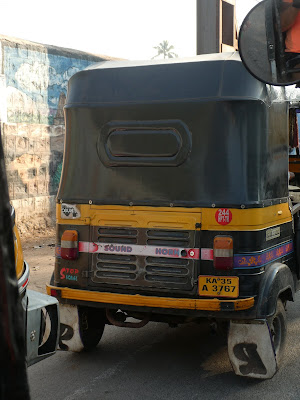

C'est ici à Mysore qu'on vient voir le palais dit le plus délirant du Sud de l'Inde. La visite de cette splendeur donne une idée de la puissance et de la folie des grandeurs des maharajas d'antan. Tout y est, portes en argent massif, miroirs, plafonds magnifiques en teck sculpté, couleurs délirantes, marbre incrusté de pierres précieuses. Pas une salle pareille. À l'origine, le palais fut construit en bois, détruit par le feu en 1897, il fut reconstruit dans un style (attention ça prend du souffle) mi-hindou, mi-moghol, mi-gothico-victorien dit style indo-sarracenique conçu par des architectes anglais. Aujourd'hui encore, un maharajah y habite.
In Mysore, you come to see the crazyest palace in the South of India. The visit is stunning and gives a idea of the power and the megalomania of the past maharajas. Everything is there, silver doors, mirrors, splendid ceilings in sculpted teck, amazing colours, marbles with gems. Not any similar room. The palace was constructed in wood, destructed in 1897 and was re-constructed in the following style: get ready, you need some breath : half-hindu, half moghul, half indo sarracenic. Still today, a maharajah lives there.
Je ne sais pas si c'est vrai mais il est dit que ce palais est le deuxième monument après le Taj Mahal le plus visité en Inde.
I don't know whether it is true, but apparently this palace is the second monument the most visited in India after the Taj Mahal.
 |
| Salle du durbar publique - Public durbar room |
 |
| le pavillon de mariage avec sa verrière fabriquée à Glasgow - The wedding pavillion with its glass roof made in Glasgow |
 |
| Le nouveau maharajah - The new Maharajah ! |
 |
| Une vraie Chinoise ! Posing like a Chinese Woman ! |
Le soir, il est possible d'aller voir un show genre son et lumière. Le palais est éclairé de milliers de lumières et c'est féérique!
In the evening, it's possible to see a light and sound show. The palace is illuminated with thousands of lights and it's magical !
Mysore c'est aussi le "Devaraja Market" , un des plus beaux marchés du Sud de l'Inde. Il sent bon le jasmin, il est propre sans être aseptisé, authentique ( peu ou pas de touriste), un endroit où les guirlandes de fleurs se vendent au mètre. La fabrication est faite sur place. On y trouve des sacs de piments des légumes frais, des fruits , des teintures en poudre, des blocs de sucre, des ustensiles de cuisine, et j'en passe. Un vrai bonheur où il fait bon traîner les pieds le matin de bonne heure ou en fin d'après-midi.
In Mysore, we also visited the Devaraja Market, one of the prettiest market in the South of India. It smells jamine, it's clean without being sanitized, authentic (very few tourists), a place where flower guirlands are sold by the meter. The guirlands are made right there. You can also find chilis, fresh vegetables, fruits, pigments, blocks of sugar, kitchen utensils and more... A real pleasure where it is good to wander early in the morning or at the end of the day.
 |
| De beaux stands de légumes - Beautiful vegetable spots |
 |
| Des guirlandes de fleurs - Flower Guirlands |
 |
| Pigments |
 |
| Les tuk-tuks servent aussi au transport de bananes - The tuktuks are used also for the transportation of bananas |
 |
| Encore des fleurs - More flowers |
Après Mysore, direction Hampi...et encore une fois, Shiva, Shiva pas...On n'a presque renoncer à y aller tellement ce fut un casse-tête mais on est en Inde . La solution que nous avons presque retenu fut le bus couchette et le seul qui partait de Mysore pour Hampi partait le soir et arrivait le matin vers 5 h. Pour finir, on a misé sur Gozo Cab , ce qui nous permit de partir à 8h00 du matin et d'arriver vers 14h30 à Hospet, situé à une dizaine de kilomètres de Hampi. Les hôtels se trouvent plus à Hospet.
After Mysore, Hampi... and once again, we go or we don't go... We almost gave up. We were going to go with a sleeper bus but the only one who left Mysore was leaving in the night and was arriving at 5 am. In the end, we used Gozo Cabs again. We left in the end at 8am and arrived at 2:30 pm in Hospet where most hotels are located about 10 kms from Hampi.
On vient dans l'état du Karnataka pour Hampi, un haut lieu de pèlerinage pour les hindous. Imaginez un site gigantesque, près de 400 temples éparpillés sur 30 kilomètres carrés dans une nature tropicale hérissée de collines et de rochers arrondis couleur de sable avec quelque part en son milieu une rivière tranquille, la rivière Tungabhadra où les fervents vont faire leur dévotion, leur bain, leur toilette de fond en comble...toujours habillés ou presque. Un vrai spectacle tout en couleur..Sans compter les cérémonies religieuses qui se passent au bord de l'eau, et c'est long, préparation des offrandes, enduit des offrandes sur l'autel, nettoyage de l'autel, nouvel enduit de l'autel, bénédiction du brahmane et finalement, un peu de nourriture partagée sur la feuille de banane qui a été préalablement lavée dans la rivière...
You go to the state of Karnataka for Hampi, a pilgrimage place for Hindus. It's a gigantic place, with about 400 temples spread out on 30 square kilometers in a tropical jungle with hills and yellowish round rocks with the river Tungabhadha flowing. The fervents make their devotion, take their bath, clean themselves... always clothes on or almost. A real show with many colours. Many religious ceremonies take place along the river and it takes time : preparation of the offerings, coating of the offerings on the altar, cleaning of the altar, new coating of the altar, blessing of the brahman and in the end, sharing of some food laying on a banana leaf previously washed in the river...








 |
| Cérémonie au bord de la rivière ! Ceremony close to the river shore |
Cette cité des Rois Vijayanagar rivalisa dès le XIV siècle avec Benares (Viranisi). Tout allait bien jusqu'en 1565. La gloire de Hampi engendra des jalousies, les musulmans du Nord décidèrent de s'intéresser de très près à ce qui se passait dans le Sud. Et ce fut l'affrontement. Le roi hindou et ses 100,000 hommes et ses 5500 éléphants ne parvinrent cependant pas à tenir tête aux 5 Sultans Unis pour l'occasion.
This city of the Vijayanagar Kings was competing with Benares (Virannisi). Everything was going well until 1565. Hampi was creating some jealousy and the muslims in the north decided to take interest on what was happening in the south. There was a war. The Hindu king with its 100000 men and their 5500 elephants were not enough against the 5 sultans who were united at the time.
Conclusion, la cité fut pillée et incendiée . Oubliée jusqu'au XIX siècle, l'intérêt du site resurgit grâce à un écossais mais ce n'est que 150 ans plus tard et après 10 années de recherches archéologiques que celui-ci fut inscrit au Patrimoine de l'UNESCO (en 1986).
The city was looted and set on fire. Forgotten until the 19th century, the interest in the site comes back thanks to a Scott but it's only 150 years later and after archeological researches during 10 years that the site will become part of the Worldwide Heritage of UNESCO (1986).
Parmi les sites incontournables à aller voir, le Virupaksha Temple, Hemakutam Temple, Krishna Temple, l'image de Narasimha, le complexe royal, Mathanga Hill, Vitthala Temple... de quoi nous tenir occupés !
The must see are the Virupaksha Temple, Hemakutam Temple, Krishna Temple, Narasimha image, the Royal Complex, Mathanga Hill, Vitthala Temple... We are busy ...
 |
| Virupaksha Temple |
 |
| Devant un Ganesha - In front of Ganesha |
 |
| Sasivekalu Ganesha (2,40 mètres de haut) avec 4 bras - Sasivekalu Ganesha (2,40 meters high) with 4 arms |
 |
| Krishna Temple |
 |
| Devant l'image de Narasimha - In front of the Narasimha Image |
Et un petit clin d'oeil à Carine et Quentin que nous avions rencontré au Mexique dans leur 2CV...
And a small wink to Carine and Quentin that we had met in Mexico in their 2CV...
 |
| Hemakutam Temple |
 |
| View from the Mathanga Hill - Vue de la Colline Mathanga |
 |
| Hazarama Temple |
 |
| Lotus Mahal, mix of hindu and muslim style - Lotus Mahal avec des éléments de style hindu et d'autres islamiques |
 |
| ''Etables'' pour éléphants - Elephant Stables |
 |
| Belle position - Nice posture ! |
 |
| Queen's bath - Le bain de la Reine |
 |
| Devant le char en pierre tiré par des éléphants au Temple Vitthala...- In front of the Stone Chariot pulled by elephants at the Vitthala Temple... |
 |
| Représenté sur le billet de 50 roupies - Featured on the 50 rupee banknote |
Et partout des sculptures extraordinaires par leur finesse, leur grâce...
and everywhere extraordinary sculptures being so fine and gracious...
 |
| Pilliers sculptés - Sculpted pillars |
Prévoir 2 jours pour s'imprégner de l'atmosphère spéciale qui règne à Hampi.
2 days needed to soak in the special atmosphere of Hampi.
On the Road Again 3...
Ecrit par Alain - Written by Alain














































































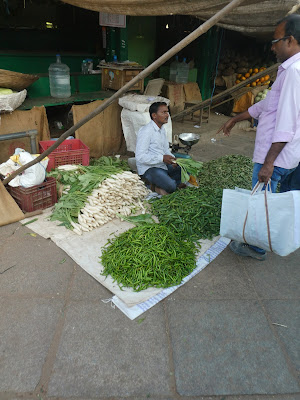











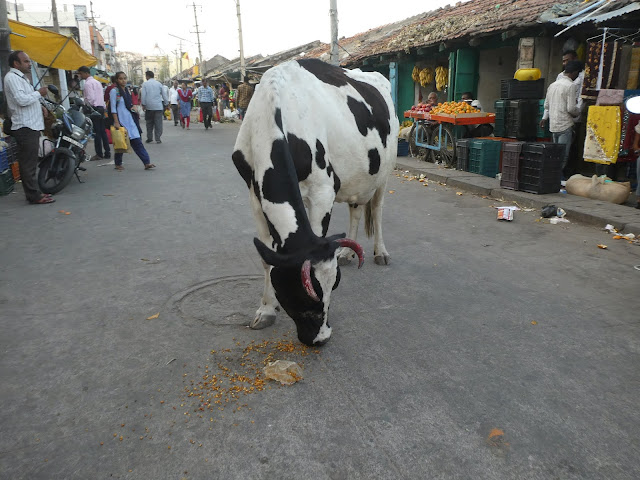























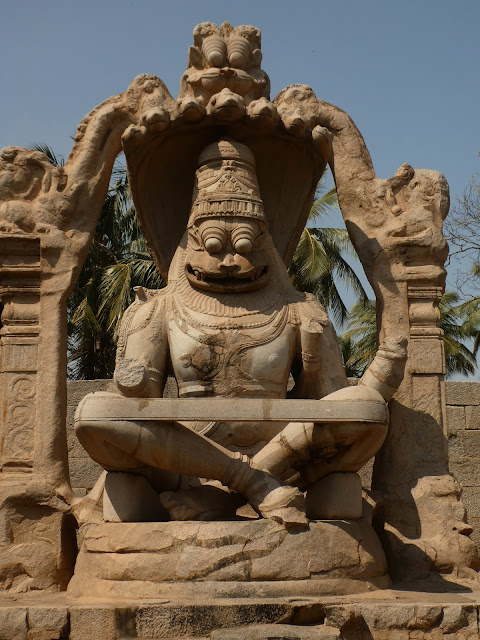
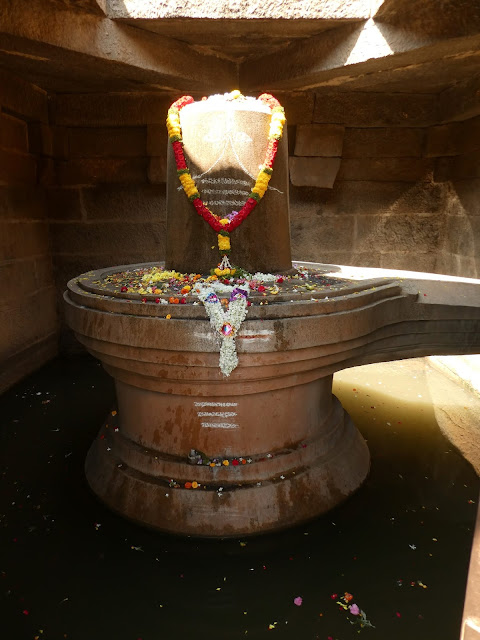


























No comments:
Post a Comment